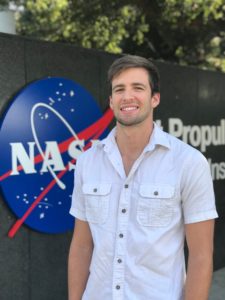Southeast Missouri State University 2017 alumnus Colten Peterson recently was awarded a Future Investigators in NASA Earth and Space Science and Technology (FINESST) research grant.

Southeast alumnus Colten Peterson, pictured here at the NASA Jet Propulsion Laboratory in Pasadena, California, where he is collaborating with the Atmospheric Infrared Sounder (AIRS) team this summer on his graduate research.
Peterson, from Champaign, Illinois, and now a University of Michigan doctoral student, was awarded the grant to fund his research proposal titled Improving Arctic Cloud Phase Retrievals using Far-Infrared Radiances. The grant will fund his research for three years as he works to improve satellite retrievals of Arctic cloud phase.
Clouds play an important role in the Arctic climate system by warming the surface through the absorption and emission of infrared radiation, he said. The clouds phase, or whether it is composed of ice crystals or liquid droplets, can influence the overall radiative impact.
Because ground observations in the Arctic are lacking, satellite measurements are needed to further understand the complex seasonal and spatial distributions of Arctic cloud phase, he said.
Current satellite cloud phase estimation techniques have significant limitations, especially in the Arctic, Peterson said.
The highly competitive FINESST research grant is awarded only to top applicants and provides support for relevant research and technology development project training in disciplines needed to achieve the goals of NASAs Science Mission Directorate (SMD). NASAs SMD is focused on using space observatories to conduct scientific studies of the Earth from space to return samples from other bodies in the solar system and to peer into the galaxy and beyond. FINESST grants are for student-designed research projects that contribute to SMD’s science, technology and exploration goals.
Peterson was one of 121 selected for the award from 966 proposals. Petersons proposal competed in the Earth Science field in which only 59 of 428 proposals were awarded a grant.
I literally jumped out my chair when I found out that I had been selected, he said. Through this award, I have secured my own research funding for the duration of graduate school. It also means that I have freedom to pursue research that am I most interested in.
He plans to work alongside his advisor, Dr. Xianglei Huang, associate professor of climate and space science and engineering at the University of Michigan, to develop a cloud phase discrimination algorithm to improve and expand climate research.
In his proposal, he describes a method of using a part of the infrared spectrum called the far-infrared to discriminate Arctic cloud phase from the satellite level. Far-infrared radiation emitted into space carries information about cloud phase and is particularly useful in the cold and dry polar regions, Peterson said.
Historically, no satellite instruments have made measurements in the far-infrared with narrow channels, but that will soon change with the upcomingNASA PREFIRE mission, he said.
Given the historic opportunity that PREFIRE represents, it is pertinent for the scientific community to begin developing cloud phase discrimination algorithms that use the far-infrared.
In his proposal, Peterson described a strategy for developing such an algorithm.
I intend for my algorithm to benefit future far-infrared missions and improve our current methods of cloud phase discrimination. Improving our knowledge of Arctic cloud phase across this vast region will help us to understand the role of Arctic clouds and how that role will evolve as the Arctic continues to rapidly change, he said.
Receiving the prestigious grant has encouraged Peterson, who is beginning his third year of doctoral study, to continue his research interests and explore career opportunities. After graduating in 2022 with a doctorate in atmospheric, oceanic and space sciences, he hopes to secure a two-year post-doctoral position.
Receiving this NASA-sponsored grant gives me the opportunity to demonstrate that I can write a proposal and get it funded, which is one of the most important skills that my future employers will look for, Peterson said. I am strongly considering applying for NASA post-doctoral positions. Long-term, I am interested in working as a research scientist at a NASA center or as a professor at a research-focused university.
Peterson, a Cape Central High School graduate, earned a double major in physics and engineering physics, mechanical applications option, and a minor in applied mathematics at Southeast.
The knowledge he gained at Southeast made his success in the doctoral program possible, Peterson said.
Through Southeasts Tutorial Services, I was able to teach for nine semesters, which provided me vital communications skills that I use on a daily basis, he said. The unwavering support from faculty at Southeast allowed me to pursue both internal research and multiple research internships around the country during the time I was an undergraduate. This helped me build fundamental research skills. My time at Southeast provided the foundation for my doctoral work, giving me the physical science background that I needed.